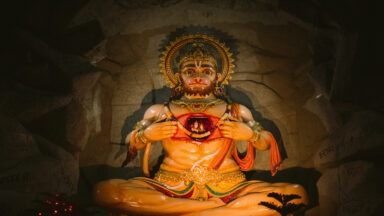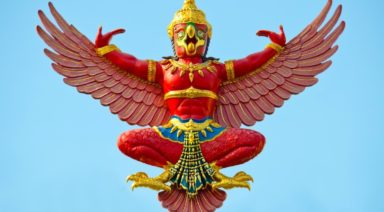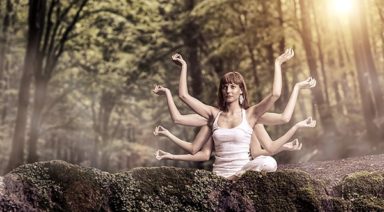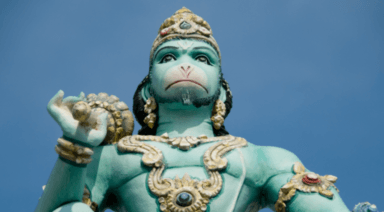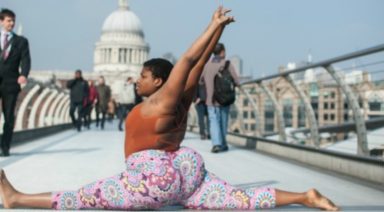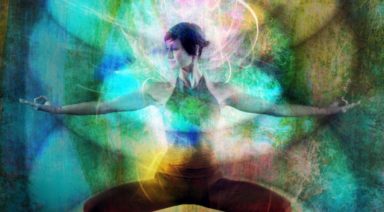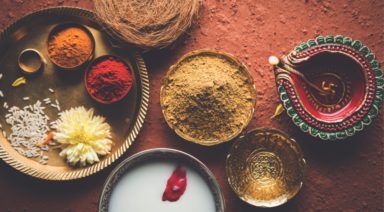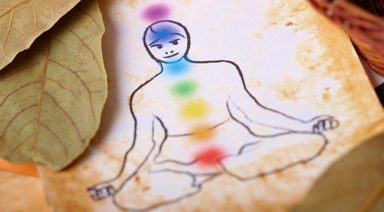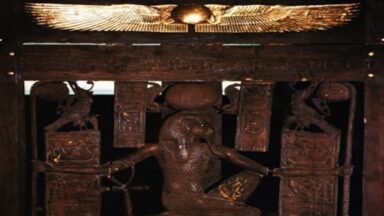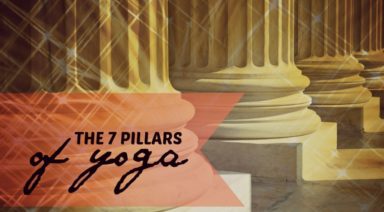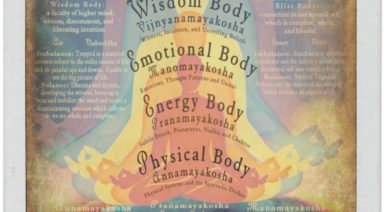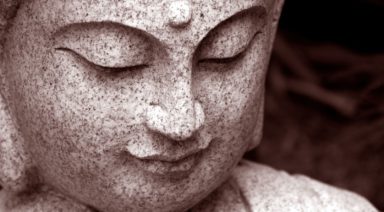How Krishna Brings Love and Non-Attachment Into Your Life
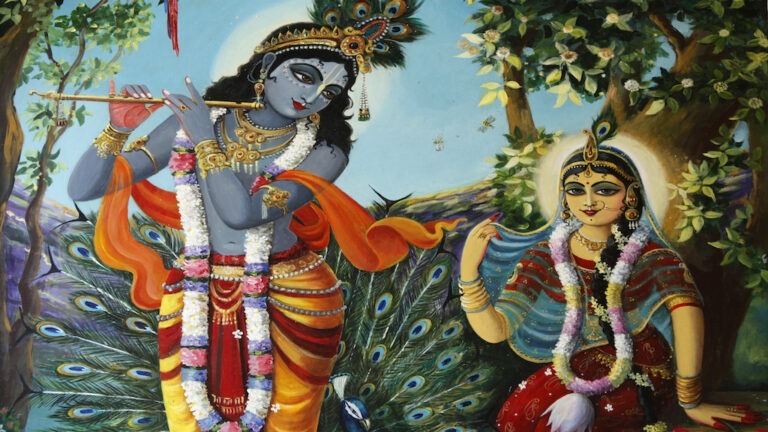
Vishnu, the Sustainer or Preserver, is a very important deity in Hinduism. He is one of the Trimurti, or the Holy Trinity, which consists of Brahma (the Creator), Vishnu (the Preserver), and Shiva (the Destroyer). In terms familiar to us, the three stand for beginnings, middles, and endings.
Through yoga, we begin to understand that everything has a beginning, a middle, and an end. Our practice is what helps us be more in the flow of everything which is constantly and always changing. As the Sustainer of the Universe, Vishnu is much like the breath that sustains our bodies or the love that sustains our soul.
Krishna the Gopala
When Vishnu descended to Earth in his Krishna avatar form, he was young. In his schoolboy years, he was also known as Govinda or Gopala. Govinda or Gopala means Cowherd or Finder of Cows. Gopala was often seen surrounded by cows and calves while playing his instrument, the flute. He tended to the cows within an agricultural community named Gokula, teaching many about the importance of cattle and how to sustain healthy relationships between humans and cows.
Krishna’s love for cattle is reflected in the yoga pose gomukasana, or cow face pose. It’s a seated hip opener that represents a cow head. The legs are bent and stacked on top of one another at the knees (cow mouth) and the arms assume archer’s arms (cow ears).
What Krishna teaches us about the cow face is that it is the best face we assume for people in our world whom we love and care about deeply. We learn to put our best cow face forward!
It’s how you choose to show up in the best way for your family, friends, and even some acquaintances in need. Your cow face should reflect how good of a listener you are to a struggling friend, how you as a parent choose to help your kids when they’re in a bind, or how great of a dog parent you are. We all have these beautiful tendencies, our cow faces. These are our ways of showing our love and ability to care and to take care of our tribe.
The next time you find yourself attempting cow face pose, instead of focusing on how tight your shoulders and your hips are, focus on something else. How could you put your best cow face forward for yourself in the pose? That’s Vishnu demonstrating to us in different ways how to sustain and take care of ourselves in the practice.
Non-attachment
Vishnu as Krishna or Govinda in his younger form loved to be outside in nature, playing his flute. One day he noticed his music had started drawing crowds of young women. The young women were also cow herders (gopis). By this popularity, he also came to be known as ‘the all-attractive one.’ When the gopis heard the beautiful lilting call of Govinda’s music, their heartstrings were tugged. Much like taking a break from daily tasks to make your way to your yoga mat, the girls would temporarily leave any burdens behind to go dance, revel in the music, and relish in nature.
Because Vishnu represents the love that sustains our soul, what the gopis were feeling in their hearts and bodies was a call to divine love. Make no mistake – divine love is not something we need to work hard towards achieving. It’s about remembering our own true nature and our ability to love and accept ourselves unconditionally. True nature exists beyond our everyday worries, concerns, and our limiting belief systems.
Govinda’s flute music gatherings started to gain in popularity and he had a brilliant idea. He decided to have a yoga rave party. Because he COULD, he divided himself up into 1,008 Krishna Govindas! They scattered themselves all through the forest and started jamming. The forest was vibrating with all the good vibes as the music of a thousand flutes filled the trees. The tree trunks vibrated, the branches shimmied, and the leaves danced. You could almost see the musical notes dancing between the leaves!
The girls felt the effects of the surround sound from the forest rave in their bodies and hearts. They immediately stopped what they were doing. All the gopis from all the surrounding villages came to the yoga rave and started singing and dancing and twirling. I always say music is the shortest umbilical cord to the soul. We feel happy, alive, and totally present. The pull toward the feeling of divine love was also a glimpse into the nature of the soul.
One of the girls who came to the yoga rave was named Radha. She was believed to have been blind for most of her childhood. It was when she first set her blind eyes on Govinda that she was immediately able to see. Many believe she opened her eyes because of being in the presence of a god. They were right. She was a favorite friend and eventually wife of Krishna.
Have you ever had an out-of-body experience? Or a glimpse of your own immense power? We get a quick feeling, or a glimpse, but something inevitably pulls us back to our humanity.
That’s what happened to each gopi. They were swirling and dancing and singing ecstatically in the woods, lost in the good vibes of divine love.
In the middle of the ecstatic dance, each one at some point saw Krishna. And in each of those moments, each one of them thought they wanted him only for themselves. And it’s true that sometimes when you’re inspiring a feeling of self-love in a person, they mistake it for an external love and they project it on you!
As each gopi wanted Krishna for herself and began clutching and grasping for him, he disappeared. POOF! Gone. His offering of true love was unable to survive around expectation or controlling energy or grasping. He disappeared for all the gopis. All the girls except for one: Radha. Because of what she had learned from being a blind child, and because of what she knew of Krishna, she knew better than to attach herself to any outcome. And from then on, Krishna and Radha became a pair.
Where could a little Vishnu go a long way in your life? A reminder of unconditional self-love and acceptance? An effort to put your best cow face forward for yourself or a loved one? Or a gentle reminder to take a step back from the need to control or wallow in expectation. This is when we breathe, feel into our bodies and heart (get present), and perhaps call on Vishnu.
OM NAMO BHAGAVATE VASUDEVAYA
This mantra calls upon the energy of love and the divine being that exists in each heart. The feelings of love that arise from this mantra help us overcome any barriers of love to ourselves; any obstacles we are encountering.
Hanuman; The Ancient Monkey-Superman
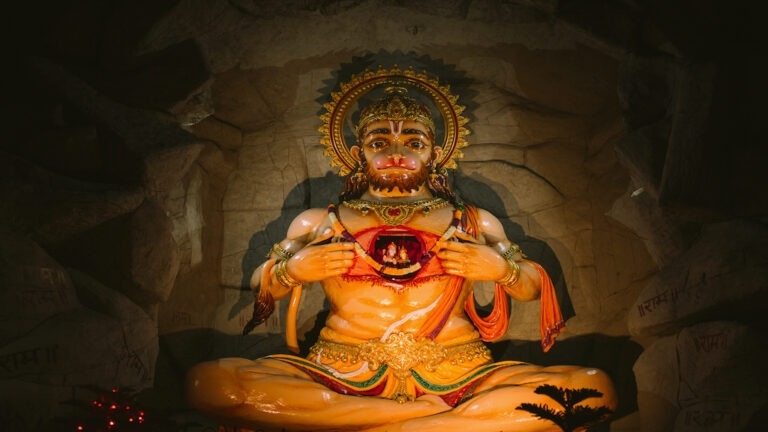
The monkey god Hanuman, was given the birth name Anjaneya (powerful, fiery). He earned this name Hanuman when he was quite young. Playing in some green, grassy fields, Hanuman looked up and saw a big, orange, juicy sun and mistook it for a giant mango. Monkeys love mangoes!
He decided to leap into the sky and steal the mango for his afternoon snack. Indra Devi, the Sky God, saw what was happening on his home turf and became quite angry at Hanuman’s imposition, so he began throwing lightning bolts every which way. One of the lightning bolts hit Hanuman in the jaw (‘Hanu’ means jaw) and propelled him to the earth where he landed with a dramatic thump, killing him.
All the deities panicked in seeing his lifeless little body. They knew Hanuman’s dad would be furious, and he was. Vayu, the God of the Wind, saw his little son lying on the ground, lifeless. He went into grief and rage and started sucking the air out of the universe. Everything started to wither, shrivel up, and die; just like young Hanuman.
The deities came out from where they were hiding and begged Vayu to restore balance to the universe, to give it back its ability to live, breathe, and exist. Vayu claimed he would only do so if they brought his son back to life. Everyone readily agreed, as each deity walked over to Hanuman’s lifeless body and touched him. Each god who touched him infused a little life back into him, and unbeknownst to Hanuman, a little bit of their power.



